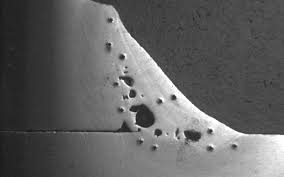Comprehensive Guide: What is Porosity in Welding and How to avoid It
Comprehensive Guide: What is Porosity in Welding and How to avoid It
Blog Article
Comprehending Porosity in Welding: Exploring Causes, Impacts, and Prevention Strategies
Porosity in welding is a consistent challenge that can considerably impact the quality and stability of welds. As professionals in the welding industry are well conscious, comprehending the reasons, impacts, and prevention techniques connected to porosity is essential for achieving robust and trustworthy welds. By diving right into the root causes of porosity, examining its detrimental impacts on weld top quality, and checking out reliable prevention methods, welders can enhance their knowledge and abilities to produce high-quality welds constantly. The detailed interplay of elements adding to porosity requires a thorough understanding and an aggressive strategy to make sure successful welding end results.
Usual Reasons of Porosity
Porosity in welding is largely brought on by a mix of aspects such as contamination, incorrect protecting, and inadequate gas coverage throughout the welding procedure. Contamination, in the form of dirt, grease, or rust on the welding surface area, creates gas pockets when heated up, resulting in porosity in the weld. Incorrect protecting occurs when the protecting gas, frequently used in procedures like MIG and TIG welding, is incapable to fully shield the molten weld pool from reacting with the bordering air, resulting in gas entrapment and succeeding porosity. In addition, inadequate gas protection, usually due to incorrect circulation rates or nozzle positioning, can leave components of the weld vulnerable, enabling porosity to form. These variables collectively contribute to the development of voids within the weld, deteriorating its integrity and possibly causing architectural issues. Recognizing and attending to these common reasons are essential actions in avoiding porosity and making certain the quality and toughness of welded joints.
Impacts on Weld Top Quality
The presence of porosity in a weld can substantially compromise the overall quality and stability of the welded joint. Porosity within a weld produces spaces or tooth cavities that compromise the framework, making it much more susceptible to fracturing, rust, and mechanical failure. These voids work as tension concentrators, reducing the load-bearing capability of the weld and boosting the chance of early failure under used stress. Additionally, porosity can likewise work as possible sites for hydrogen entrapment, more intensifying the destruction of the weld's mechanical residential or commercial properties.
Furthermore, porosity can hinder the performance of non-destructive testing (NDT) strategies, making it challenging to find various other flaws or gaps within the weld. This can bring about considerable safety and security concerns, specifically in important applications where the architectural honesty of the welded elements is critical.

Prevention Techniques Introduction
Provided the harmful impact of porosity on weld quality, reliable prevention techniques are essential to keeping the architectural stability of bonded joints. Among the key prevention strategies is comprehensive cleaning of the base products before welding. Pollutants such as oil, oil, rust, and moisture can add to porosity, so ensuring a clean work surface is necessary. Correct storage space of welding consumables in dry problems is also critical to avoid wetness absorption, which can bring about gas entrapment during welding. Furthermore, choosing the ideal welding criteria, such as voltage, current, and travel rate, can assist minimize the risk of porosity formation. Ensuring appropriate protecting gas flow and insurance coverage is one more essential avoidance strategy, as inadequate gas coverage can lead to climatic contamination and porosity. Lastly, appropriate welder training and qualification are necessary for executing safety nets efficiently and continually. By including these avoidance strategies right into welding home methods, the occurrence of porosity can be substantially minimized, leading to more powerful and a lot more reliable welded joints.
Value of Appropriate Shielding
Correct protecting in try here welding plays a critical role in protecting against atmospheric contamination and making sure the stability of bonded joints. Securing gases, such as argon, helium, or a mix of both, are generally made use of to protect the weld pool from reacting with components in the air like oxygen and nitrogen. When these reactive components enter contact with the warm weld pool, they can trigger porosity, causing weak welds with decreased mechanical residential or commercial properties.

Inadequate shielding can lead to numerous flaws like porosity, spatter, and oxidation, endangering the architectural stability of the welded joint. For that reason, adhering to correct protecting practices is vital to generate high-grade welds with marginal flaws and make certain the long life and integrity of the bonded elements (What is Porosity).
Surveillance and Control Approaches
Just how can welders successfully keep track of and regulate the welding procedure to ensure ideal results and prevent flaws like porosity? By continually monitoring these variables, welders can determine inconsistencies visit our website from the excellent conditions and make immediate modifications to prevent porosity formation.

In addition, implementing correct training programs for welders is important for keeping an eye on and managing the welding procedure efficiently. What is Porosity. Educating welders on the value of preserving regular parameters, such as correct gas securing and travel speed, can aid prevent porosity concerns. Normal assessments and accreditations can likewise make sure that welders are skilled in monitoring and managing welding processes
Moreover, the usage of automated welding systems can enhance monitoring and control capabilities. These systems can specifically control welding parameters, minimizing the likelihood of human mistake and making sure regular weld top quality. By combining sophisticated monitoring modern technologies, training programs, and automated systems, welders can successfully check and control the welding procedure to reduce porosity problems and achieve high-quality welds.
Verdict

Report this page